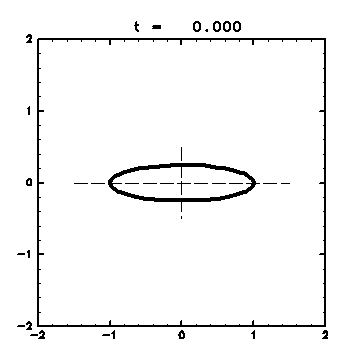4.1 Time Evolution of an Unstable Elliptical Vortex
Time evolution of an elliptical vortex patch with a small perturbation is calculated. The time evolution depends on the oblateness of the ellipse and the wavenumber of the perturbation ( Horii,1997 ).
The initial contour shape is
 (4.1)
(4.1)
inside of which the vorticity is constant q = 2π ,
and outside of which q = 0.
This type of elliptical vortex rotates with a constant angular velocity g= 2pl/ ( 1 +l
)2,
depending on the ratio of the major axis to the minor axis l
( Lamb,1932 ).
A small perturbation is added to the elliptical vortex in the form
( Dritschel,1989 ):
 (4.2)
(4.2)
In the case of m = 3 , the elliptical vortex is unstable when l
> 3
( Love,1893 ).
